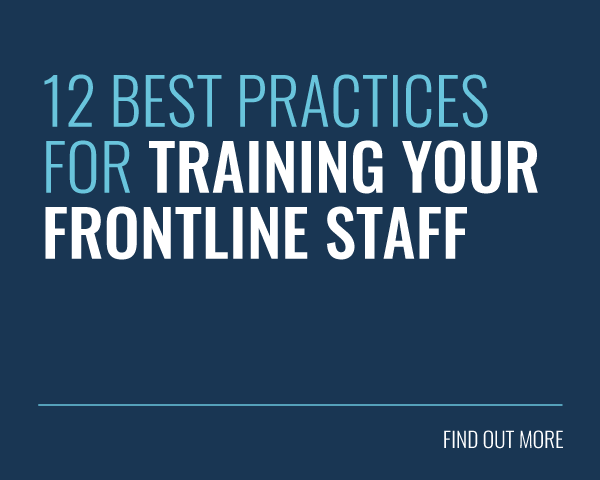With some things in life, it’s easy to see how effort equates to success. The more a houseplant has been tended to, the healthier and bigger it looks. A footballer scoring a goal is down to years of rigorous practice (or the goalkeeper’s lack of).
The success metrics of training are somewhat clouded, however. Despite what your headmaster or boss told you, it’s not all about test results or hours worked. There are many other L&D success metrics which gauge how much employees have understood from a training session.
Looking for training metrics that matter? All training metrics matter!
From a collective change in behaviour to toppling individual goals; let’s take a look at the parameters with which we can measure the success of our training…
Five L&D Success Metrics That Matter
1. Skills and Expertise
It’s easy to forget that job roles can constantly evolve. You never have to stop learning! A content producer can write blogs, produce videos, become proficient in SEO optimisation and much, much, much more (…ahem…). This sharing and harvesting of internal knowledge is what we call intellectual capital.
How to Measure the Growth of Skills and Expertise:

You can measure the progress of skills and experience by introducing markers before and after training. This can be implemented in the form of a test, or if you’re feeling particularly kind, a quiz. Both of these can be created via Growth Engineering Learning App mobile app.
You may also want to track Battle results across a period of time. This is a sure-fire way of seeing improvement!
How to Improve on it:
They say the best way to learn is to teach. How about encouraging your employees to share a tip sheet on the social feed of your learning app?
2. Goal Achievements
Did you know, FitBit users take 43% more steps that non-FitBit users? This is because their progress can be monitored, and they have daily targets they are motivated to achieve. This is why it’s so important for employees to have set goals.
A Harvard Business Study found that the 3% of graduates from their MBA who had their goals written down, ended up earning ten times as much as the other 97% put together, just ten years after graduation. That’s the power of goal setting.
How to Measure it:
Setting goals naturally gives you a metric for success. If an employee achieves a set goal, then you can be sure the training has been successful! Eureka!
So, what kind of goals can you set to measure the success of your training? By and large, it’s job-specific.
Here are some examples to give you a flavour of how to do it:
- Sales: 5% increase in sales conversions
- Retail: 10% increase in average basket size
- Tech Support: Bug response time reduced by 30%
How to Improve on it:
You can improve the direction and focus of employee goals by introducing SMART goals to proceedings.
SMART goals are often used to help measure targets and to help you focus. SMART stands for the following:
- S – Specific
- M – Measurable
- A – Achievable
- R – Relevant
- T – Time-Based
3. Behaviour Change

Behaviour change is an essential ingredient to make sure your training impacts the workplace. As such, it is one of the best success metrics to consider when estimating the impact of your L&D interventions.
From learning campaigns to social learning to gamification; there are a host of strategies you can use to initiate a change in behaviour. Employee behaviour change is a huge motive for training.
Want to know more? Download our awesome guide ‘The Science of Behaviour Change.’
Want to know even more?! Of course you do! Our very own Juliette can be found below discussing behaviour change via The Hook Model:
How to Measure it:
Why not use gamification? Evaluation doesn’t have to be boring! You could ask your managers to reward their team members with a praise badge every time they apply the new behaviour in the workplace.
You can then run reports on this behaviour to see whether your training has stuck!
How to improve on it:
Line managers can create reminders to keep the changes on track. Take push notifications for example. You can use this digital form of a finger poke to remind learners they need to consume content NOW!
Whatever the change in behaviour is, it’s worth keeping in mind that it takes 66 days to form a habit, so have a little patience.
4. Employee Engagement Levels
Did you know, 73% of workers who say they work at a purpose-driven company are engaged? You can use training as a chance to inform your learners about the purpose of your organisation! It’s a powerful way to boost employee engagement.
The more you engage a learner in their training, the more likely they are to be engaged during their work time. It makes sense, training will improve learner competency and the better a learner is at their job, the more likely they are to enjoy it.
Boost employee engagement levels during training and you’ll soon see the results shine through.
How to Measure It:
If you deliver your training on a swanky LMS that’s pumped full of the best features then measuring engagement is a dream! Take our Academy LMS as an example, if you want to measure engagement you have a powerful reporting and analytics suite to give you all the information you could possibly dream of. Here are some suggestions:
- You could simply measure logins
- Track content completions over time
- Report on engagement in social feeds – how many posts? What about likes?
- Track Battles completed over time
How to Improve on it:
Gamify your training and you’ll soon see engagement levels go through the roof! Gamification is the use of game mechanics in non-gaming environments. This can include leaderboards, virtual badges, experience points and much more. Gamification can bring out positive competition in all of us. In fact, a whopping 50% of employees benefit from workplace competition.
5. Employee Productivity
We’re all looking to boost productivity. Be it individually or as a team. So how do you measure the metrics of employee productivity?
How to Measure it:
Employees who are engaged by their training experience will project a newfound confidence and ownership within their roles. Productivity is one of the easiest metrics to measure as it’s all in the results of their daily efforts. For example, if a bricklayer is re-trained and given new incentives to improve productivity, then you can see the results by the number of bricks laid. If a sales executive is motivated to make more calls, then again, you’ll soon see the effects by the number of calls made.
How to Improve on it:
Gamify there experience by introducing leaderboards and XP. You can even garner more productivity by offering real-life rewards such as free meals etc.
Final Words

The truth is, there are many employee training metrics that measure the success of your training campaign. But it goes beyond test results. Some of these L&D success metrics can be measured with their tangible results, such as individual and team goal achievements.
A sales executive reaching targets is a good example. HR training metrics might be filling positions. Some are a bit harder to track. Behaviour change, employee engagement and productivity can all be improved given the right training.
Most of the time you can see the success in the individual. If they have a passion to learn and succeed, then the training has been a success!
Through successful training, you can encourage employee behaviour to change. This is essential to getting a return on investment. Check out our guide: ‘The Science of Behaviour Change’ and start making changes now!





